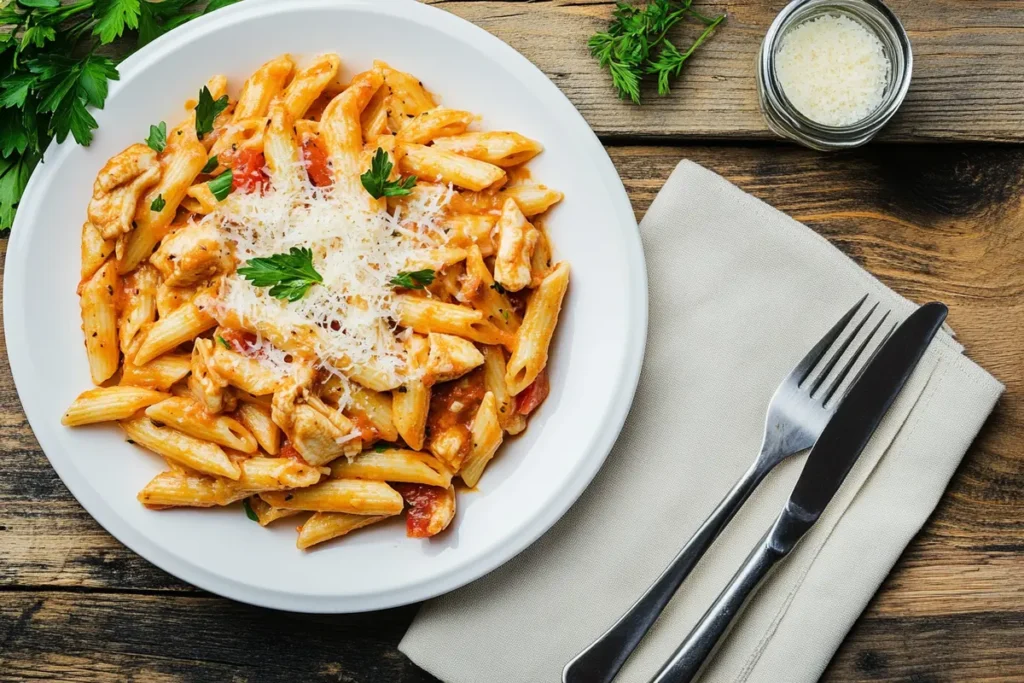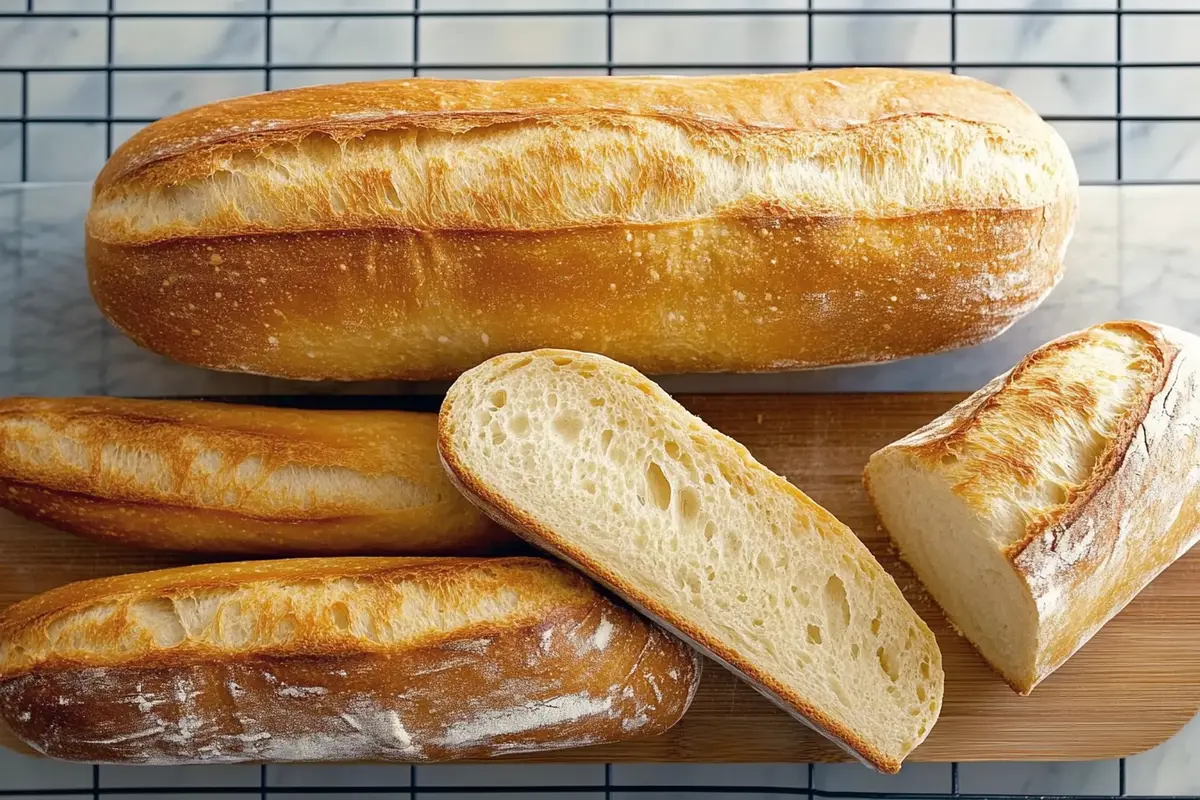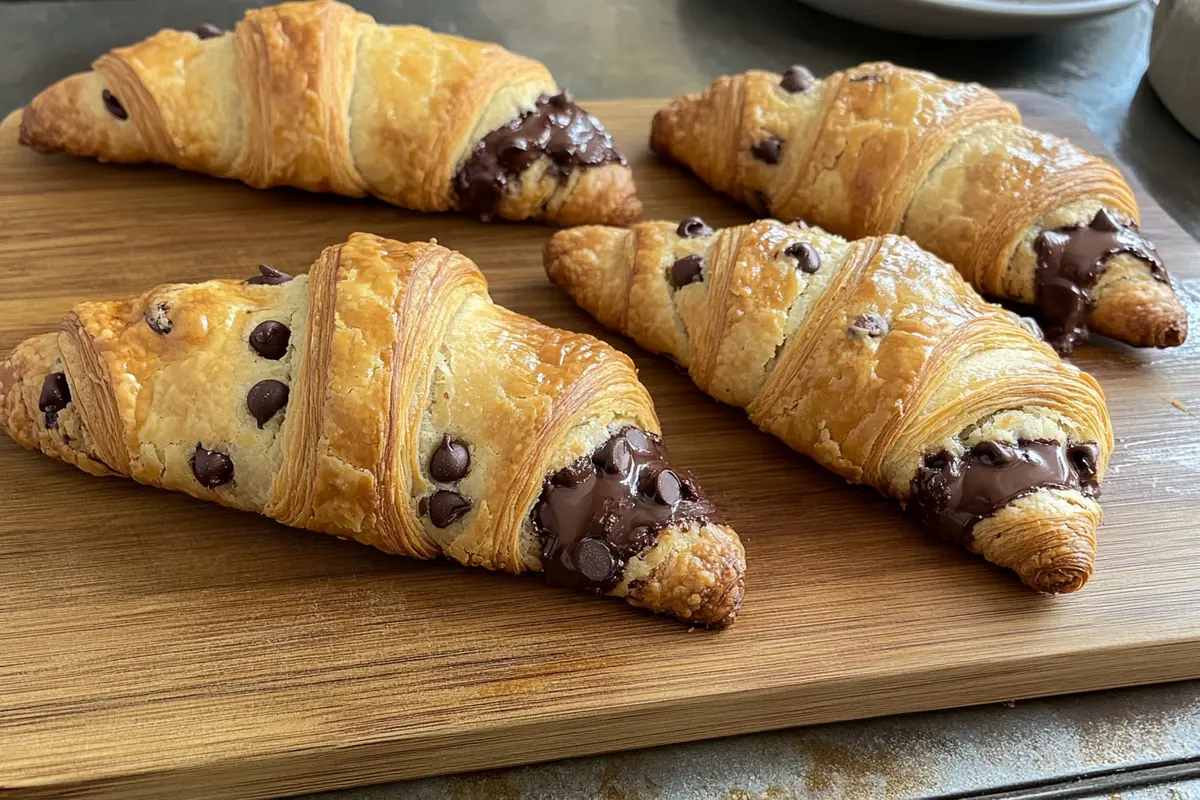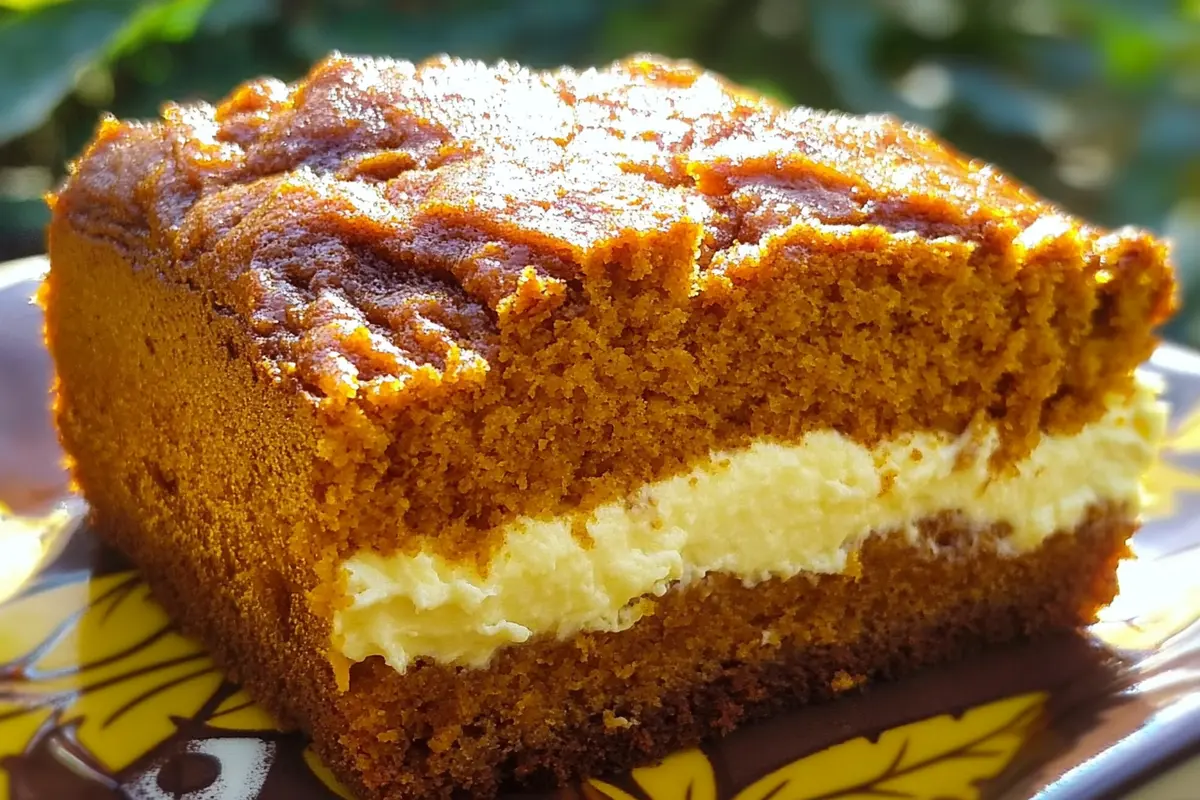When it comes to comfort food, few dishes rival the creamy, flavorful magic of Garlic Parmesan Chicken Pasta. This rich and hearty recipe combines the succulent taste of seasoned chicken with a velvety Parmesan sauce and perfectly cooked pasta. Whether you’re preparing a quick weeknight meal or an indulgent weekend treat, this dish ticks all the boxes.
Understanding the Ingredients
Key Components of Garlic Parmesan Chicken Pasta
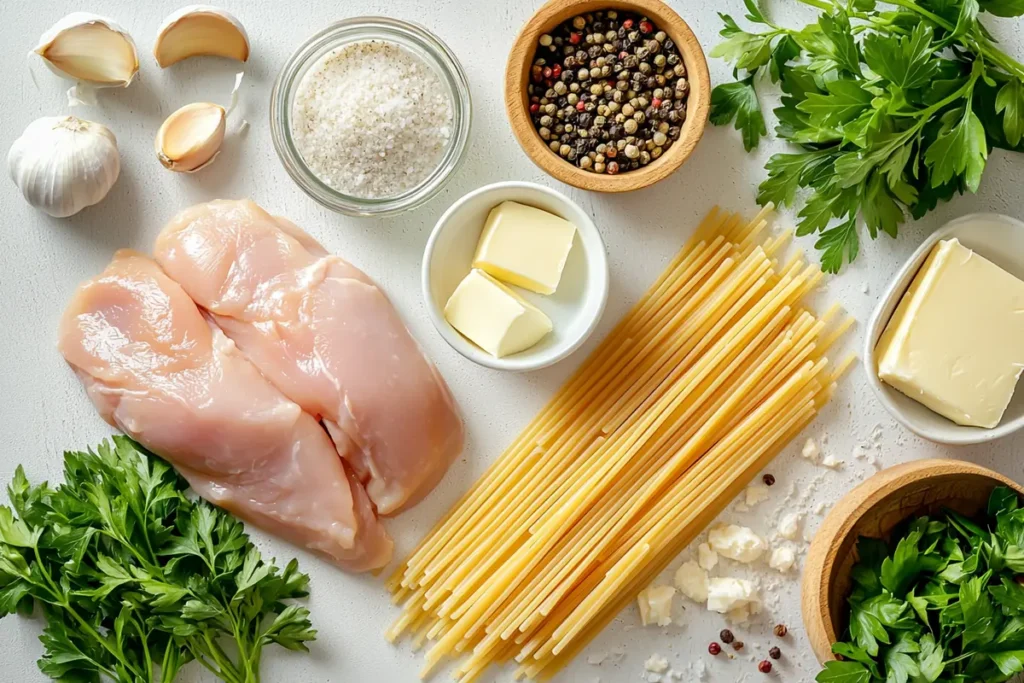
Creating an unforgettable dish starts with understanding the core ingredients. Each component, from the protein to the aromatics, plays a pivotal role in delivering the perfect balance of flavor and texture.
Chicken Selection
When it comes to choosing chicken for Garlic Parmesan Chicken Pasta, you can’t go wrong with boneless, skinless chicken breasts. They’re lean, tender, and cook quickly. If you’re after a juicier, more flavorful option, chicken thighs are excellent due to their higher fat content. To prepare, trim any excess fat and pat the chicken dry to ensure even browning. Seasoning with salt, pepper, and a touch of garlic powder enhances the natural flavors. Cooking the chicken until golden brown creates a savory base for the pasta.
Pasta Varieties
The type of pasta you use can dramatically change the dish’s final presentation. Fettuccine, with its wide, flat shape, is a classic choice because it holds onto the creamy sauce beautifully. Penne and rigatoni are excellent alternatives, with their ridges trapping every bit of garlic Parmesan goodness. If you prefer a more delicate option, linguine offers a lovely texture. Whichever you choose, cooking the pasta al dente is essential. This ensures the pasta doesn’t become mushy when mixed with the sauce.
The Role of Garlic
Garlic is undeniably the star of this recipe, infusing the dish with its rich, aromatic flavor. For the best results, use fresh garlic cloves instead of pre-minced varieties, which often lose their potency. Mince or grate the garlic finely to ensure even cooking and optimal flavor distribution. As it sautés in butter, the garlic releases its fragrant oils, setting the stage for the luscious sauce.
Crafting the Perfect Sauce
Creamy Parmesan Sauce: The Heart of the Dish
Ingredient Breakdown
- Heavy Cream: This provides the sauce’s luscious, creamy base. Its high fat content ensures a smooth, velvety finish.
- Parmesan Cheese: Freshly grated Parmesan cheese is the star of the show, adding a sharp, nutty flavor. Pre-grated options may contain anti-caking agents that can affect the sauce’s texture.
- Butter: A generous pat of butter helps sauté the garlic and creates a glossy finish. It also balances the flavors.
- Seasonings: Simple yet essential, salt and freshly ground black pepper highlight the other ingredients. A pinch of crushed red pepper flakes adds a subtle kick for spice lovers.
Achieving the Ideal Consistency
The key to a creamy sauce lies in finding the right balance between thickness and fluidity. Start by melting butter over medium heat, then add minced garlic and cook until fragrant. Slowly stir in the heavy cream, allowing it to warm gradually. Over high heat, cream can separate, so maintain a gentle simmer.
As the sauce heats, add the Parmesan cheese gradually, whisking continuously to avoid clumping. If the sauce feels too thick, a splash of pasta water works wonders to loosen it while maintaining its richness. For a thicker sauce, let it simmer for a few more minutes, stirring occasionally to prevent sticking.
Flavor Enhancements
To take the sauce to the next level, consider adding herbs like fresh parsley or basil. For a zesty twist, a squeeze of lemon juice brightens the flavors beautifully. If you’re feeling adventurous, stir in a pinch of nutmeg for warmth. These subtle tweaks can elevate the dish from good to gourmet.
Cooking Techniques for Garlic Parmesan Chicken Pasta
Step-by-Step Preparation Guide
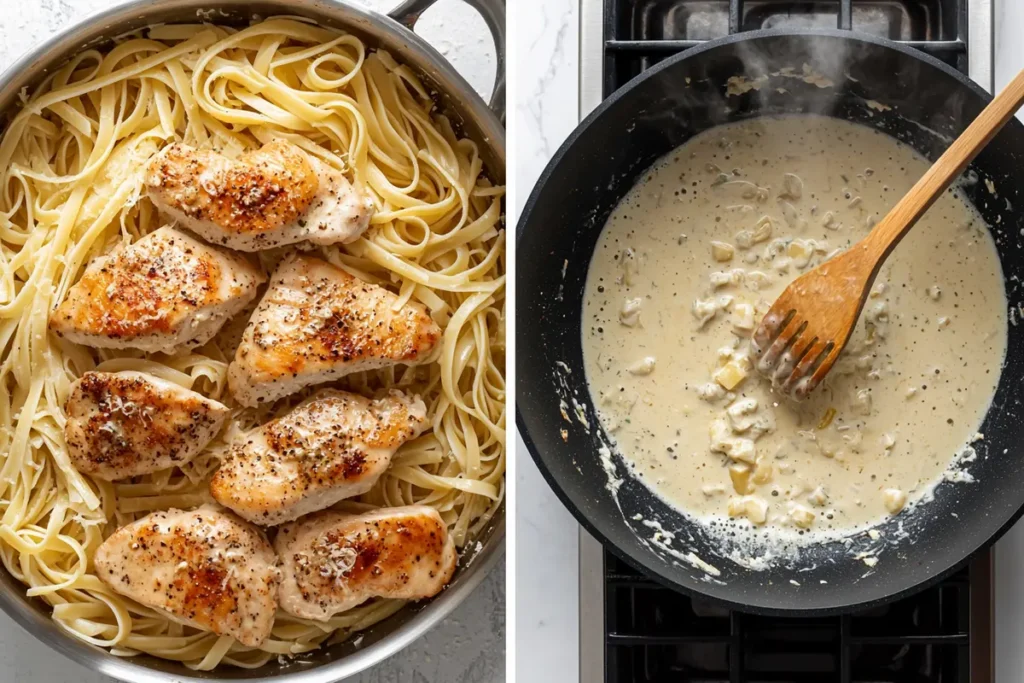
Preparing the Chicken
Start by seasoning the chicken generously with salt, pepper, and garlic powder. For an added layer of flavor, a sprinkle of Italian seasoning can do wonders. Heat a large skillet over medium heat, adding a tablespoon of olive oil or butter to prevent sticking.
Place the chicken in the skillet, ensuring it’s not overcrowded. Let it sear without moving for 4–5 minutes on each side. This creates a beautiful golden crust while sealing in the juices. If using chicken breasts, consider pounding them to an even thickness for faster, more uniform cooking. Once done, transfer the chicken to a cutting board and allow it to rest for 5 minutes before slicing into strips or bite-sized pieces. Resting ensures the juices redistribute evenly.
Cooking the Pasta
While the chicken cooks, bring a large pot of salted water to a boil. Salt is crucial as it infuses flavor directly into the pasta. Add your choice of fettuccine, penne, or linguine and cook according to the package instructions until al dente—firm to the bite yet tender.
Reserve about a cup of the starchy pasta water before draining. This liquid can later be used to adjust the sauce’s consistency without diluting its flavor. Once drained, toss the pasta lightly in olive oil to prevent sticking while you prepare the rest.
Combining Ingredients
Return the skillet to medium heat, leaving behind the residual oil and fond from cooking the chicken—it’s packed with flavor. Pour in the creamy Parmesan sauce (prepared earlier) and allow it to warm gently. Stir in a splash of reserved pasta water to achieve the desired consistency.
Next, add the cooked pasta to the skillet, tossing it thoroughly to coat every strand in the sauce. Finally, mix in the sliced chicken, ensuring even distribution. The key is to let the flavors meld for a minute or two on low heat without overcooking the chicken or pasta.
Variations and Dietary Considerations
Customizing Garlic Parmesan Chicken Pasta
Healthier Alternatives
For a lighter version of this indulgent dish, simple substitutions can make a significant difference. Start with swapping traditional pasta for whole wheat pasta. It adds a nutty flavor and packs extra fiber, making the dish more filling and nutritious.
When it comes to the sauce, reduced-fat cream or a mix of low-fat milk and Greek yogurt can mimic the richness of heavy cream while cutting down on calories. Alternatively, opt for a roux-based sauce made with olive oil, flour, and milk for a lower-fat option.
Using lean chicken breast and cooking it with minimal oil is another great step toward a healthier plate. Pair these tweaks with a generous portion of steamed vegetables like broccoli or spinach mixed into the pasta for added vitamins and minerals.
Vegetarian Adaptations
Transforming Garlic Parmesan Chicken Pasta into a vegetarian delight is easier than you might think. Replace the chicken with hearty plant-based proteins such as tofu, tempeh, or seitan. These alternatives soak up the flavors of the sauce beautifully when cooked with the same seasonings.
Another option is incorporating roasted vegetables like zucchini, mushrooms, or bell peppers for texture and flavor. Adding legumes such as chickpeas or white beans not only boosts protein content but also complements the creamy sauce with their mild, buttery taste.
To retain the dish’s richness, stick with the Parmesan cheese, or use a vegetarian-friendly cheese if needed. The result is a meal that’s satisfying enough to please even the most ardent meat lovers!
Gluten-Free Modifications
For those avoiding gluten, gluten-free pasta is an excellent substitution. Varieties made from rice, corn, or chickpea flour are widely available and hold up well under creamy sauces.
To thicken the sauce without flour, use cornstarch or arrowroot powder. Dissolve a teaspoon of the thickener in cold water before adding it to the sauce, ensuring a smooth consistency. This way, you can enjoy the creamy goodness of Garlic Parmesan Chicken Pasta without worrying about gluten.
Pairing Suggestions
Complementary Side Dishes and Beverages
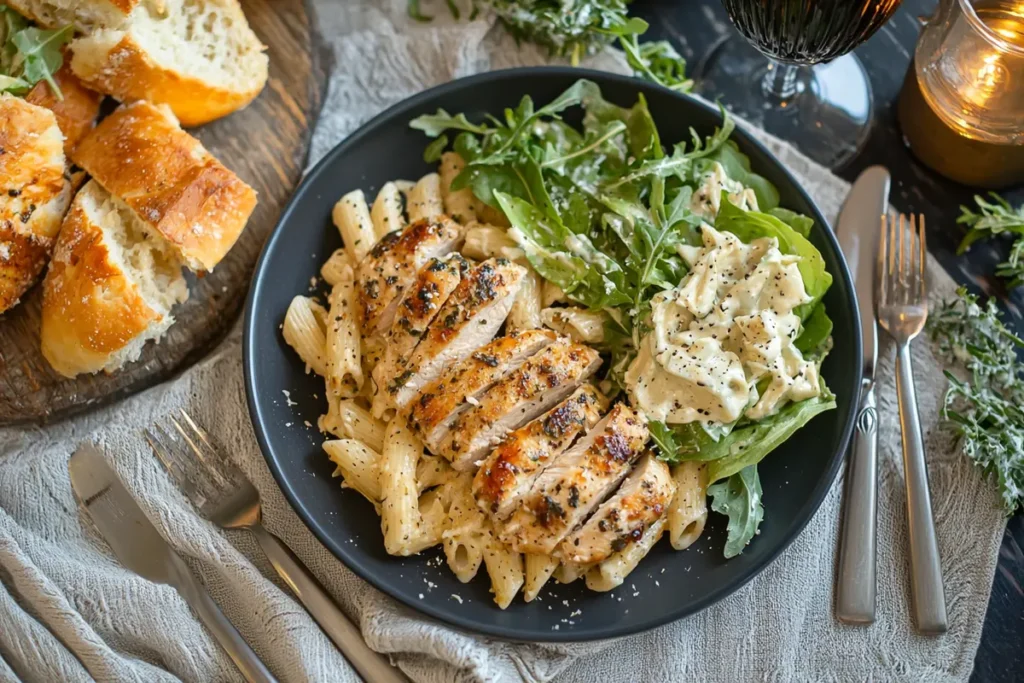
Pairing your Garlic Parmesan Chicken Pasta with the right sides and drinks can elevate the meal into a memorable dining experience. Here’s how to complement this creamy dish perfectly.
Ideal Side Dishes
To balance the richness of the pasta, consider serving it alongside a fresh, crisp salad. A Caesar salad with crunchy croutons and a zesty dressing is a classic choice. Alternatively, a simple green salad with a light vinaigrette works wonders.
Garlic bread is another favorite accompaniment. The buttery, garlicky slices are perfect for scooping up every last bit of sauce. For a heartier option, serve roasted vegetables like asparagus, zucchini, or brussels sprouts. Their natural sweetness and slight char provide a delightful contrast to the creamy pasta.
Non-Alcoholic Options
For a refreshing drink, sparkling water infused with lemon or lime is an excellent choice. It cuts through the richness of the dish without overpowering its flavors. Unsweetened iced tea or cucumber water also pair wonderfully, adding a subtle, cleansing finish.
Frequently Asked Questions
Can I use pre-grated Parmesan cheese?
While pre-grated Parmesan may seem convenient, it often contains anti-caking agents that can affect the sauce’s texture and flavor. Freshly grated Parmesan cheese melts smoothly and delivers a more robust, nutty taste, making it well worth the extra effort.
How can I store and reheat leftovers?
To store leftovers, transfer the pasta into an airtight container and refrigerate for up to 3 days. When reheating, add a splash of milk or cream to restore the sauce’s creaminess. Gently heat in a skillet over medium-low heat, stirring frequently to prevent sticking. Avoid microwaving, as it can dry out the dish.
Is it possible to make this dish ahead of time?
Yes, you can prepare parts of the dish in advance. Cook the chicken and store it separately. The sauce can be made a day ahead and refrigerated in an airtight container. When ready to serve, cook the pasta fresh, reheat the sauce, and combine everything for a quick, hassle-free assembly.
What protein alternatives can I use?
Shrimp is a fantastic alternative that pairs beautifully with the garlic Parmesan sauce. If you’re looking for a vegetarian option, tofu or tempeh, seasoned and lightly sautéed, are excellent choices for retaining the dish’s satisfying texture.
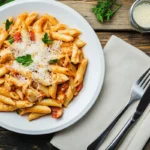
Garlic Parmesan Chicken Pasta: The Ultimate Recipe for a Creamy Delight
- Total Time: PT40M
- Yield: 4 servings 1x
Description
This creamy Garlic Parmesan Chicken Pasta is the ultimate comfort food! Tender pan-seared chicken, al dente pasta, and a rich, garlicky Parmesan cream sauce come together in one deliciously satisfying dish.
Ingredients
For the Chicken:
-
2 boneless skinless chicken breasts (about 1 lb), cut into strips
-
1 tablespoon olive oil
-
1 teaspoon garlic powder
-
1/2 teaspoon salt
-
1/2 teaspoon black pepper
For the Pasta:
-
8 oz penne pasta (or fettuccine, linguine)
-
Water for boiling
-
1/2 tablespoon salt (for pasta water)
For the Sauce:
-
2 tablespoons unsalted butter
-
4 garlic cloves, minced
-
1 cup heavy cream
-
1 cup freshly grated Parmesan cheese
-
1/2 teaspoon salt (to taste)
-
1/4 teaspoon black pepper
-
1/4 teaspoon red pepper flakes (optional)
-
1/4 cup reserved pasta water (as needed)
Optional Garnish:
-
Fresh chopped parsley
-
Extra grated Parmesan
Instructions
-
Cook the pasta: In a large pot, bring salted water to a boil. Add pasta and cook until al dente, according to package instructions. Reserve 1/4 cup of pasta water before draining. Set aside.
-
Prepare the chicken: Season chicken strips with garlic powder, salt, and pepper. In a large skillet over medium heat, heat olive oil. Add chicken and sear for 4–5 minutes on each side, or until golden and cooked through. Remove from pan and set aside.
-
Make the sauce: In the same skillet, melt butter over medium heat. Add minced garlic and sauté for about 1 minute until fragrant.
-
Add the cream: Pour in heavy cream and bring to a gentle simmer, stirring occasionally.
-
Incorporate cheese: Slowly stir in Parmesan cheese until melted and the sauce thickens slightly. Season with salt, pepper, and red pepper flakes (if using).
-
Combine everything: Add cooked pasta to the sauce, tossing to coat. Add reserved pasta water a bit at a time if the sauce needs thinning.
-
Finish: Return the chicken to the pan, stirring until everything is evenly coated and warmed through.
-
Serve: Plate the pasta, garnish with parsley and extra Parmesan, and enjoy hot!
Notes
Variations: Try it with shrimp, tofu, or mushrooms for a twist.
Healthier Options: Use whole wheat pasta and reduced-fat cream or Greek yogurt.
- Prep Time: PT15M
- Cook Time: PT25M
- Category: Dinner, Pasta
- Method: Stovetop
- Cuisine: Italian, American
Nutrition
- Serving Size: 1/4 of recipe
- Calories: 620 kcal
- Sugar: 2 g
- Sodium: 680 mg
- Fat: 36 g
- Saturated Fat: 18 g
- Unsaturated Fat: 15 g
- Trans Fat: 0.5 g
- Carbohydrates: 40 g
- Fiber: 2 g
- Protein: 40 g
- Cholesterol: 135 mg
Keywords: garlic Parmesan chicken pasta, creamy chicken pasta, one-pan pasta, chicken Alfredo alternative, pasta dinner, Italian chicken pasta, garlic cream sauce, Parmesan pasta recipe

